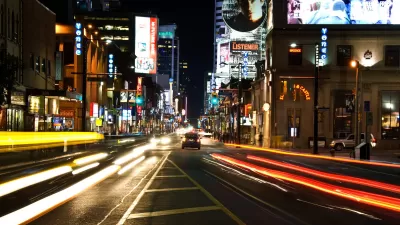“Despite long ago having fallen from favour among North American city planners and traffic engineers, the multi-lane, multi-use, tree-lined avenue will soon return to our fair burg,” writes Christopher Hume.
Thanks to Waterfront Toronto, the tripartite agency responsible for the transformation of Queens Quay, “[w]hat’s now a messy and dysfunctional downtown thoroughfare will become an elegant street shared equally by cars, public transit, pedestrians, cyclists — and trees,” reports Hume. The project has been in the pipeline for years, but is finally breaking ground and will be under-construction for at least two years. “From a larger civic perspective, the transformation is also a milestone” asserts Hume, stating that “[s]ince the 1930s, traffic engineers have avoided boulevards because they are thought to be at odds with their preferred 'functional' approach.”
Dutch landscape architect, Adriaan Geuze, who’s firm West 8 won the international redesign competition for Queens Quay in 2006, will transform what he refers to as “the waterfront boulevard” in Toronto, from an "dangerous" place full of potential and in dire need of improvement, to one that is still bustling, but friendlier for all users. “In North America,” Geuze says, “people are totally dependent on the car. So they’re used to the car being prioritized. We’re not against cars, but we do want to make more space for pedestrians and cyclists. We want transit to be totally integrated. We want pedestrians to hang around. We have to live together. These things should be celebrated.”
“Though Queens Quay won't become a boulevard in the classic sense, it will look and act like a boulevard. There will be two traffic lanes, down from four, and the remaining space will be given to bicycles, streetcars, walkways and several rows of trees.” writes Hume. He lauds Toronto for not shying away from complexity in its land use policies, but instead embracing it, something he sees as critical as thc city continues to grow.
FULL STORY: A boulevard runs through it: the Queens Quay remake

Maui's Vacation Rental Debate Turns Ugly
Verbal attacks, misinformation campaigns and fistfights plague a high-stakes debate to convert thousands of vacation rentals into long-term housing.

Planetizen Federal Action Tracker
A weekly monitor of how Trump’s orders and actions are impacting planners and planning in America.

In Urban Planning, AI Prompting Could be the New Design Thinking
Creativity has long been key to great urban design. What if we see AI as our new creative partner?

King County Supportive Housing Program Offers Hope for Unhoused Residents
The county is taking a ‘Housing First’ approach that prioritizes getting people into housing, then offering wraparound supportive services.

Researchers Use AI to Get Clearer Picture of US Housing
Analysts are using artificial intelligence to supercharge their research by allowing them to comb through data faster. Though these AI tools can be error prone, they save time and housing researchers are optimistic about the future.

Making Shared Micromobility More Inclusive
Cities and shared mobility system operators can do more to include people with disabilities in planning and operations, per a new report.
Urban Design for Planners 1: Software Tools
This six-course series explores essential urban design concepts using open source software and equips planners with the tools they need to participate fully in the urban design process.
Planning for Universal Design
Learn the tools for implementing Universal Design in planning regulations.
planning NEXT
Appalachian Highlands Housing Partners
Mpact (founded as Rail~Volution)
City of Camden Redevelopment Agency
City of Astoria
City of Portland
City of Laramie



























